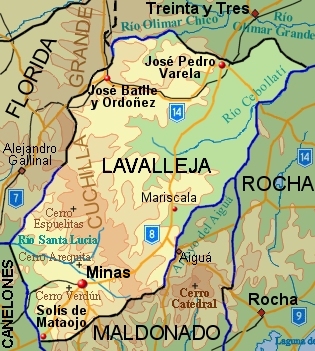|
Adriana Peña
María Adriana Peña Hernández (born 9 March 1964 in Minas, Uruguay, Minas) is a Uruguayan dentist and politician, belonging to the National Party (Uruguay), National Party. Since 2010 she has been the Intendant of Lavalleja Department, the first woman ever to hold that post. References Living people 1964 births Intendants of Lavalleja Department University of the Republic (Uruguay) alumni Uruguayan dentists National Party (Uruguay) politicians Women mayors of places in Uruguay 21st-century Uruguayan women politicians 21st-century Uruguayan politicians {{Uruguay-mayor-stub ... [...More Info...] [...Related Items...] OR: [Wikipedia] [Google] [Baidu] |
Minas, Uruguay
Minas () is the capital of the Lavalleja Department in Uruguay. As of the census of 2011, it is the twelfth-most populated city in the country. Geography The city is located in the south of the department, on the intersection of Route 8 (Uruguay), Route 8 with Route 12 (Uruguay), Route 12. It lies between hill ranges and the basins of the Arroyo San Francisco and Arroyo Campanero streams. History A town was founded here in 1783 as "Villa de la Concepción de las Minas" when a number of families from the Asturias and Galicia (Spain), Galicia regions of Spain settled in the area following a frustrated attempt to populate Patagonia. The idea of a city in the area was first raised in 1753 by Jose Joaquin de Viana, the governor of Montevideo, who wanted to create a population centre in "the zones of the mines". He commissioned Rafael Perez Del Puerto to design the layout of the city, the basis of which remains in place today. On October 8, 1830, it was declared a town, and on June 16 ... [...More Info...] [...Related Items...] OR: [Wikipedia] [Google] [Baidu] |
Uruguay
Uruguay, officially the Oriental Republic of Uruguay, is a country in South America. It shares borders with Argentina to its west and southwest and Brazil to its north and northeast, while bordering the Río de la Plata to the south and the Atlantic Ocean to the southeast. It is part of the Southern Cone region of South America. Uruguay covers an area of approximately . It has a population of almost 3.5 million people, of whom nearly 2 million live in Montevideo metropolitan area, the metropolitan area of its capital and List of cities in Uruguay, largest city, Montevideo. The area that became Uruguay was first inhabited by groups of hunter gatherer, hunter gatherers 13,000 years ago. The first European explorer to reach the region was Juan Díaz de Solís in 1516, but the area was colonized later than its neighbors. At the time of Spanish colonization of the Americas, European arrival, the Charrúa were the predominant tribe, alongside other groups such as the Guaraní people ... [...More Info...] [...Related Items...] OR: [Wikipedia] [Google] [Baidu] |
National Party (Uruguay)
The National Party (, PN) also known as the White Party (), is a major political party in Uruguay. Founded in 1836 by General Manuel Oribe, it is the country's oldest active political party, and along with the Colorado Party (Uruguay), Colorado Party, its origin dates back to the History of Uruguay, establishment of Uruguay as an independent state. Positioned on the centre-right of the political spectrum, the National Party is ideologically Liberalism, liberal, Nationalism, nationalist, Pan-Americanism, Pan-Americanist and Humanism, humanist. Considering the interim co-government of the ''Gobierno del Cerrito'' headed by Manuel Oribe, and the Gobierno de la Defensa, Defense Government from Montevideo led by the Colorado Joaquín Suárez, Joaquín Suarez, in the middle of the Uruguayan Civil War, and with the exception of the Presidency of Luis Lacalle Pou, administration of Luis Lacalle Pou, the PN has ruled the country for 35 years interruptedly throughout its history. The part ... [...More Info...] [...Related Items...] OR: [Wikipedia] [Google] [Baidu] |
Lavalleja Department
Lavalleja (; ) is a department of Uruguay. Its capital is Minas. It is located in the southeast of the country, bordered to the north by the department of Treinta y Tres to the east with Rocha, to the south with Canelones and Maldonado, and to the west to Florida. The department is named in honor of Brigadier Juan Antonio Lavalleja, who had distinguished military and political action in the country's independence. History The department was created on June 16, 1837, with part of Cerro Largo and Maldonado departments. It was first named as Minas. In March 1888, it was asked that the Chamber of Deputies raised the settlement hierarchy of the village of Minas to be a town and to change the department's name to Lavalleja. The first was approved. From then, and until December 26, 1927, when the name was changed to Lavalleja, widespread debates about the matter were held. There was political will to designate a department under the name of the head of the Liberation Crusade, but ... [...More Info...] [...Related Items...] OR: [Wikipedia] [Google] [Baidu] |
Living People
Purpose: Because living persons may suffer personal harm from inappropriate information, we should watch their articles carefully. By adding an article to this category, it marks them with a notice about sources whenever someone tries to edit them, to remind them of WP:BLP (biographies of living persons) policy that these articles must maintain a neutral point of view, maintain factual accuracy, and be properly sourced. Recent changes to these articles are listed on Special:RecentChangesLinked/Living people. Organization: This category should not be sub-categorized. Entries are generally sorted by family name In many societies, a surname, family name, or last name is the mostly hereditary portion of one's personal name that indicates one's family. It is typically combined with a given name to form the full name of a person, although several give .... Maintenance: Individuals of advanced age (over 90), for whom there has been no new documentation in the last ten ... [...More Info...] [...Related Items...] OR: [Wikipedia] [Google] [Baidu] |
1964 Births
Events January * January 1 – The Federation of Rhodesia and Nyasaland is dissolved. * January 5 – In the first meeting between leaders of the Roman Catholic and Orthodox churches since the fifteenth century, Pope Paul VI and Patriarch Athenagoras I of Constantinople meet in Jerusalem. * January 6 – A British firm, the Leyland Motors, Leyland Motor Corp., announces the sale of 450 buses to the Cuban government, challenging the United States blockade of Cuba. * January 9 – ''Martyrs' Day (Panama), Martyrs' Day'': Armed clashes between United States troops and Panamanian civilians in the Panama Canal Zone precipitate a major international crisis, resulting in the deaths of 21 Panamanians and 4 U.S. soldiers. * January 11 – United States Surgeon General Luther Terry reports that smoking may be hazardous to one's health (the first such statement from the U.S. government). * January 22 – Kenneth Kaunda is inaugurated as the first Prime Minister of Northern Rhodesi ... [...More Info...] [...Related Items...] OR: [Wikipedia] [Google] [Baidu] |
Intendants Of Lavalleja Department
An intendant (; ; ) was, and sometimes still is, a public official, especially in France, Spain, Portugal, and Latin America. The intendancy system was a centralizing administrative system developed in France. In the War of the Spanish Succession of 1701 to 1714 the French royal House of Bourbon secured its hold on the throne of Spain; it extended a French-style intendancy system to Spain and Portugal - and subsequently worldwide through the Spanish Empire and Portuguese Empire. Regions were divided into districts, each administered by an intendant. The title continues in use in Spain and in parts of Spanish America for particular government officials. Development of the system in France Intendants were royal civil servants in France under the Old Regime. A product of the centralization policies of the French crown, intendants were appointed "commissions," and not purchasable hereditary "offices," which thus prevented the abuse of sales of royal offices and made them more tra ... [...More Info...] [...Related Items...] OR: [Wikipedia] [Google] [Baidu] |
University Of The Republic (Uruguay) Alumni
The University of the Republic (, sometimes ''UdelaR'') is a public research university in Montevideo, Uruguay. It is the country's oldest and largest university, as well as one of the largest public universities in South America in terms of enrollment. Established in 1849, it has educated the vast majority of Uruguay's professionals throughout history and has maintained a leading role in advancing academic research and higher education. The University of the Republic enrolls more than 140,000 students and is organized into 16 independent faculties. It administers 7 university schools and scientific institutes, the Hospital Clinic Manuel Quintela, as well as three regional university centers that serve different parts of the country. History The process of founding the country's first public university began on 11 June 1833, when a law proposed by then-Senator Dámaso Antonio Larrañaga was passed. It called for the creation of nine academic departments; the President of ... [...More Info...] [...Related Items...] OR: [Wikipedia] [Google] [Baidu] |
Uruguayan Dentists
Uruguayans () are people identified with the country of Uruguay, through citizenship or descent. Uruguay is home to people of different ethnic origins. As a result, many Uruguayans do not equate their nationality with ethnicity, but with citizenship and their allegiance to Uruguay. Colloquially, primarily among other Spanish-speaking Latin American nations, Uruguayans are also referred to as "'' orientals s in Easterners'" (). Uruguay is, along with much of the Americas, a melting pot of different peoples, with the difference that it has traditionally maintained a model that promotes cultural assimilation, hence the different cultures have been absorbed by the mainstream. Uruguay has one of the most homogeneous populations in South America; the most common ethnic backgrounds by far being those from Spain, Italy, Germany and France i.e. Spanish Uruguayans, Italian Uruguayans, German Uruguayans, French Uruguayans and Polish Uruguayans. Immigration waves Most Uruguayans desce ... [...More Info...] [...Related Items...] OR: [Wikipedia] [Google] [Baidu] |
National Party (Uruguay) Politicians
National Party or Nationalist Party may refer to: Active parties * National Party of Australia, commonly known as ''The Nationals'' * Bangladesh: ** Bangladesh Nationalist Party ** Jatiya Party (Ershad) a.k.a. ''National Party (Ershad)'' * California National Party * Nationalist Party of Canada * Kuomintang or ''Chinese Nationalist Party'', in Mainland China (1919–1949) and Taiwan (since 1949) * National Party (Denmark) * National Party (Ireland) * National Party of Honduras * Hong Kong National Party * Homeland Party (Libya) or ''Libyan National Party'' * Basotho National Party, in Lesotho * Nationalist Party (Malta) * Frisian National Party, in the Netherlands * New Zealand National Party * Pakistan: ** Awami National Party ** Balochistan National Party (Mengal) ** National Party (Pakistan) ** Kalat State National Party * National Party (Papua New Guinea) * Nacionalista Party, in the Philippines * Plaid Genedlaethol Cymru or ''The National Party of Wales'' * S ... [...More Info...] [...Related Items...] OR: [Wikipedia] [Google] [Baidu] |
Women Mayors Of Places In Uruguay
A woman is an adult female human. Before adulthood, a female child or Adolescence, adolescent is referred to as a girl. Typically, women are of the female sex and inherit a pair of X chromosomes, one from each parent, and women with functional uteruses are capable of pregnancy and giving childbirth, birth from puberty until menopause. More generally, sex differentiation of the female fetus is governed by the lack of a present, or functioning, ''SRY'' gene on either one of the respective sex chromosomes. Sex differences in human physiology, Female anatomy is distinguished from male anatomy by the female reproductive system, which includes the ovaries, fallopian tubes, uterus, vagina, and vulva. An adult woman generally has a wider pelvis, broader hips, and larger breasts than an adult man. These characteristics facilitate childbirth and breastfeeding. Women typically have less facial and other body hair, have a higher body fat composition, and are on average shorter and less ... [...More Info...] [...Related Items...] OR: [Wikipedia] [Google] [Baidu] |




